Verb.
Download as ppt, pdf1 like186 views
Yes, those sentences contain examples of past, present, and future verbs.
1 of 14
Download to read offline
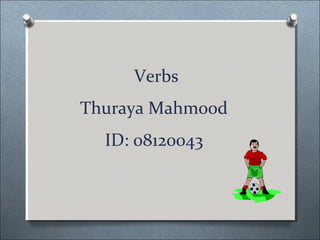
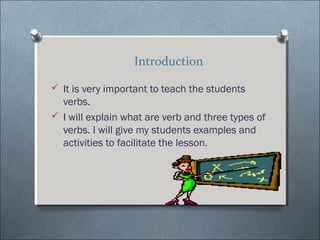

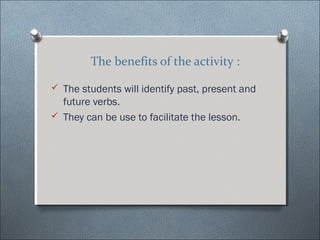
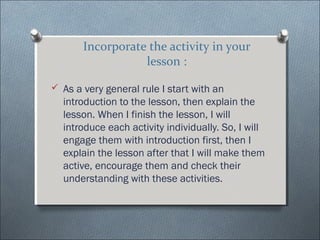

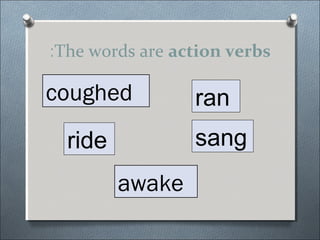
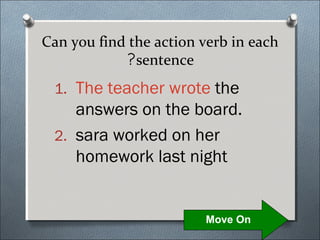
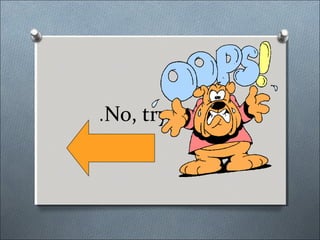
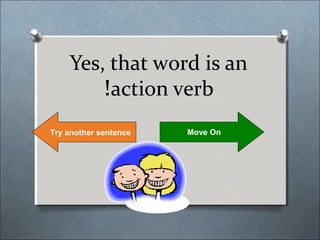
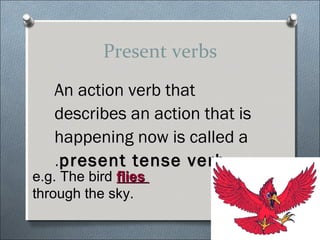
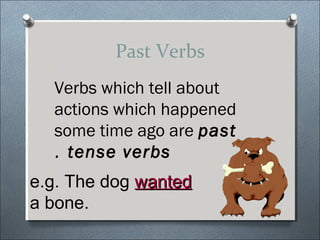

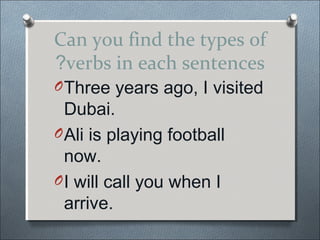
Ad
Recommended
Transitive intransitive verbs
Transitive intransitive verbsmghuerta
?
This document discusses the difference between transitive and intransitive verbs. Transitive verbs are verbs that take a direct object, such as "broke the window." Intransitive verbs do not take a direct object and describe actions where nothing receives the action, such as "cried." It is important to understand the difference, as many students and even native speakers can confuse whether a verb is transitive or intransitive. The document provides examples of common transitive and intransitive verbs and warns that prepositional phrases and adverbs do not make an intransitive verb transitive.Presentation2
Presentation2guestb4c9d2
?
The document defines and provides examples of different parts of speech in English including adjectives, adverbs, verbs, prepositions, conjunctions, and interjections. It discusses the types and degrees of adjectives, how adverbs are formed from adjectives, the active and passive forms of verbs as well as different verb tenses, and examples of common prepositions, conjunctions, and interjections.Transitive and intransitive verbs
Transitive and intransitive verbsRamlaFaisal
?
This document discusses transitive and intransitive verbs. A transitive verb denotes an action that passes from the subject to an object, and can be converted to passive voice. Examples include "She made pizza" and "The boy cut his hand." An intransitive verb denotes an action without an object and cannot be converted to passive voice. Examples include "The sun shines" and "The train stopped." To identify verb types, check if the sentence has an object or can be made passive. This helps determine if the verb is transitive or intransitive.Reported speech
Reported speechAle Masciotra
?
This document provides information on reported speech, including how to change verb tenses and time expressions when reporting something someone said. It discusses reporting statements, yes/no questions, wh- questions, and imperatives. Various reporting verbs are listed that can be used to add variety when reporting speech, such as admit, agree, offer, promise, refuse, suggest, threaten, and warn. Examples are given to illustrate reporting direct speech using these reporting verbs and tense changes.Syntax - Verb Group Vgrp
Syntax - Verb Group Vgrp Alerto Augusto Bia
?
This document discusses verbs and their classification. It defines:
1) Simple and complex verbs
2) Transitive verbs which require an object, including mono-transitive, di-transitive, and complex transitive
3) Intensive and intransitive verbs
4) Prepositional and phrasal verbs
It provides examples and notes the differences between prepositional and phrasal verbs. It concludes with tips for identifying major elements in sentences like subjects, verbs, objects.Transitive and intransitive
Transitive and intransitiveClaudia Ca?as
?
The document discusses transitive and intransitive verbs. A transitive verb has a direct object that receives the action of the verb, while an intransitive verb does not have a direct object. To determine if a verb is transitive or intransitive, ask what or whom after the verb. If there is a direct object, the verb is transitive; if there is no direct object, the verb is intransitive. Examples are provided to illustrate transitive verbs like "wrote" and "shook" as well as intransitive verbs like "applauded" and "shook." Verbs are complex but essential to sentences.Tape script (nur iwa nasuha)
Tape script (nur iwa nasuha)Syarmila Mohamad Arshad
?
This document is a slide presentation about parts of speech given by Nur Iwa Nasuha. It covers the definitions and examples of seven parts of speech: nouns, pronouns, adjectives, verbs, adverbs, prepositions, and conjunctions. For each part of speech, the presentation explains the different types and provides exercises for students to practice identifying them in sentences. Tips are also given, such as how to form plural nouns and whether a verb is transitive or intransitive. The goal is to help students learn the parts of speech through definitions, examples and exercises.Sentence
SentenceJem Alcantara
?
The document defines and provides examples of different types of sentences:
- Simple sentences contain one independent clause.
- Compound sentences contain at least two independent clauses joined by coordinating conjunctions.
- Complex sentences contain one independent clause and at least one dependent clause.
- Compound-complex sentences contain at least two independent clauses and one or more dependent clauses.Tape script (syarmila)
Tape script (syarmila)Syarmila Mohamad Arshad
?
This document is a text script for a presentation on parts of speech. It introduces the topic and lecturer. It then explains five main parts of speech - nouns, pronouns, adjectives, verbs, and adverbs - providing examples of different types within each category. Exercises are included throughout to test understanding of the parts of speech. The presentation concludes with additional exercises combining different parts of speech.Transitive. intransitive verbs by javier burgos
Transitive. intransitive verbs by javier burgosBIZ University
?
Verbs can express actions or states of being. There are two main types of verbs - action verbs and linking verbs. Action verbs take direct objects, while linking verbs link subjects to nouns or adjectives and do not take direct objects. Verbs have principal parts including the root form, past tense form, present participle form, and past participle form. Helping verbs are used with verb forms to create different tenses. Verbs can also vary by voice, mood, and whether they are transitive or intransitive.Tape script part of speech (hazwani)
Tape script part of speech (hazwani)WaniHasni
?
This document summarizes the content of 18 slides on part of speech from a lecture by Nur Hazwani Binti Hasni. It outlines the 8 parts of speech - nouns, pronouns, adjectives, verbs, adverbs, prepositions, conjunctions, and interjections. For each part of speech, it provides examples of types and exercises for students. The slides cover the definition, meaning and examples for each part of speech.Patterns after reporting verbs
Patterns after reporting verbsramiro cebreiros alvarez
?
The document outlines various verbs and their usage in reporting and discourse, emphasizing the distinction between basic verbs like 'say' and more complex verbs with richer connotations. It categorizes verbs into different patterns, such as those that require objects and those that can take multiple constructions, and provides examples for clarity. The document also discusses the grammatical structures associated with verbs like 'advise' and 'promise', highlighting their application in communication.Tape script (siti syairah)
Tape script (siti syairah)Syarmila Mohamad Arshad
?
This document summarizes a lecture on parts of speech which included slides on nouns, pronouns, adjectives, verbs, and adverbs. The slides defined each part of speech, provided examples, and included exercises for students to identify the different parts of speech in sentences. The lecture concluded with a final exercise for students to identify which part of speech various questions referred to, and the instructor provided answers to the in-class exercises.The Passive Voice
The Passive VoiceKhaled AbuZaid
?
The document explains the passive voice in English grammar, detailing its structure, uses, and transformations across different tenses. It describes how the passive voice shifts the focus from the subject to the object and provides examples of converting active sentences into passive ones. The text also covers specific structures, such as the use of modal verbs, phrasal verbs, and how to form passive structures in various contexts.Grammer for medical transcription
Grammer for medical transcriptionPriyan Jayan
?
This document provides an introduction and overview of parts of speech for medical transcription. It begins by stating that understanding parts of speech is fundamental to mastering the English language. It then defines and provides examples of several common parts of speech - nouns, verbs, adjectives. For nouns, it distinguishes between common and proper nouns. For verbs, it defines action/main verbs, linking verbs, and auxiliary/helping verbs. It also provides examples and explanations of transitive and intransitive verbs. For adjectives, it explains their purpose in modifying nouns and their typical placement in sentences.subject-verb agreement
subject-verb agreementRaudhah Sufi
?
This document discusses subject-verb agreement and active and passive voice.
It defines subjects and verbs, and provides the basic rules for subject-verb agreement in English. Singular subjects take singular verbs while plural subjects take plural verbs. It also lists exceptions like collective nouns, titles, and indefinite pronouns that can be either singular or plural.
The document also explains active and passive voice. The active voice has the subject performing the action, while the passive voice has the object of the action as the subject. It provides examples and discusses when to use each voice - active voice is more direct while passive voice de-emphasizes the actor. The rules for converting between active and passive voice are also outlinedActive Voice
Active VoiceMaeLipreso
?
The document discusses the active and passive voice of verbs. It defines the active voice as when the subject performs the action, and provides examples like "The college students defended their research study yesterday." The document also defines the passive voice and notes a verb can be transitive, needing a direct object, or intransitive without one. Examples are given to illustrate the difference between transitive and intransitive verbs. Finally, it asks which example sentence uses the active voice.THE PASSIVE VOICE
THE PASSIVE VOICEfernandolcc
?
The passive voice is used when the action is more important than the subject performing the action. It is used when the agent is unknown, unimportant, obvious, or to avoid mentioning them. The passive structure consists of the subject, a form of "to be" plus the past participle of the main verb. Only transitive verbs can be changed to the passive voice. Examples are provided of changing active sentences to the passive voice.Active and passive sentences X IPA 4
Active and passive sentences X IPA 4Restu S
?
The document provides information about verb tenses in English. It discusses 16 tenses including the present, past, and future tenses. The present tense section explains the simple present, present continuous, and present perfect tenses. The simple present is used to describe regular or repeated actions, facts, habits, and general truths. The present continuous expresses ongoing actions. The present perfect expresses actions that began in the past and have present results or relevance.Verb tenses
Verb tensesBrahmaSingh3
?
The document discusses various verb tenses in English including simple, progressive, and perfect tenses. It provides examples of how to form the present, past, and future tense of regular and irregular verbs in their simple, progressive, and perfect forms. Examples are given for the present progressive, past progressive, present perfect, past perfect, and future perfect tenses. Finally, practice sentences using various verb tenses are provided.Verbs And Verb Phrases By Dr Shadia Yousef Banjar
Verbs And Verb Phrases By Dr Shadia Yousef BanjarDr. Shadia Banjar
?
The document discusses different types of verbs and verb phrases, including:
1. Lexical verbs like "eat", "walk", and "write" versus auxiliary verbs like "be", "have", and "do".
2. Intransitive, transitive, and copula verbs. Transitive verbs are further divided into mono-, di-, and complex transitive verbs.
3. The differences between phrasal verbs like "turn on" and prepositional verbs like "call on", noting that prepositional verbs are inseparable while phrasal verbs can separate the verb and particle in certain cases.Verb Classification
Verb Classification NADA__PNU
?
This document defines and provides examples of different types of verbs:
1. Transitive verbs take a direct object. Examples given are "eats an apple" and "is reading a book".
2. Intransitive verbs do not take an object. Examples given are "listens" and "is a nice girl".
3. Ditransitive verbs take a subject and two objects, a direct object and an indirect object. An example given is "Ahmed gave the students an exam".
4. Complex-transitive verbs require a direct object and another element like an object complement. Examples given are "kate thought john a fool" and "ray told the children a story".Verb HD
Verb HDDr Sudhir Mathpati
?
The document defines verbs and their types. It discusses verbs as words that describe actions, states of being, or occurrences. It outlines six main types of verbs: 1) action vs non-action, 2) transitive vs intransitive, 3) regular vs irregular, 4) main vs auxiliary, 5) finite vs non-finite, and 6) linking verbs. Examples are provided to illustrate the differences between each verb type. linguists Verb classification
linguists Verb classification NADA__PNU
?
This document discusses different types of verbs in English including:
[1] Transitive verbs which take a direct object. Intransitive verbs do not take an object.
[2] Ditransitive verbs which take both a direct and indirect object. Common ditransitive verbs include give, show, teach.
[3] Complex-transitive verbs which take a direct object and another object or object complement.
[4] Intensive verbs which describe the subject such as is, looks.
[5] Prepositional verbs which are formed from a verb and preposition like believe in, wait for. Prepositional verbs cannot be separated.Clauses II
Clauses IILenker T
?
There are two types of clauses: independent clauses and subordinate clauses. Independent clauses can stand alone as a complete sentence while subordinate clauses cannot. Subordinate clauses are used as adjectives, adverbs, or nouns. Adjective clauses modify nouns and begin with relative pronouns like who, whom, whose, which, and that. Adverb clauses modify verbs, adjectives, or other adverbs and begin with subordinating conjunctions like after, because, where, if, that, and than. Noun clauses are used like nouns and begin with that, if, whether or not.Reported speech
Reported speechteachermercedes
?
There are two ways to relate what a person has said: direct and indirect speech. Direct speech uses the person's exact words, while indirect speech conveys the meaning without using their exact words. When changing direct speech to indirect speech, certain changes are usually made, such as changing verb tenses and pronouns. Questions and commands also require specific changes, such as changing the question structure to a statement and changing the introductory verb for commands. Different reporting verbs are used depending on the structure, such as "say" for statements and "ask" for questions.Elt methodology 1
Elt methodology 1Dyo Permana
?
Students were taught how to make sentences in the present simple third person singular through a guessing game. They were encouraged to discover grammar rules themselves by working out how language is constructed and used, then practicing with exercises using the uncovered language. Students practiced the present continuous through group games, work, and presentations.Pronouns and possesives corrected
Pronouns and possesives correctedAnne Agard
?
This document provides an overview of possessive forms and pronouns in grammar. It defines key terms like subject, object, possessive, and reflexive pronouns. Examples are given to illustrate the different types of pronouns including subject, object, possessive, and reflexive pronouns. A pronoun chart is also included that lists the subject, object, possessive, and reflexive forms for first, second, and third person singular and plural pronouns.TGIS Talks February 2013
TGIS Talks February 2013emmabruneau
?
The VP Membership discusses his toastmasters journey over the past year as a positive experience to improve public speaking skills through the supportive environment of TGIS meetings. As VP Membership, his strategy is to attract new members through high quality, lively meetings and ensure current member retention by encouraging involvement of both new and senior toastmasters. His objectives for the Excom year are to promote the TGIS club and make meetings more engaging through new member participation and cross-club attendance.More Related Content
What's hot (20)
Tape script (syarmila)
Tape script (syarmila)Syarmila Mohamad Arshad
?
This document is a text script for a presentation on parts of speech. It introduces the topic and lecturer. It then explains five main parts of speech - nouns, pronouns, adjectives, verbs, and adverbs - providing examples of different types within each category. Exercises are included throughout to test understanding of the parts of speech. The presentation concludes with additional exercises combining different parts of speech.Transitive. intransitive verbs by javier burgos
Transitive. intransitive verbs by javier burgosBIZ University
?
Verbs can express actions or states of being. There are two main types of verbs - action verbs and linking verbs. Action verbs take direct objects, while linking verbs link subjects to nouns or adjectives and do not take direct objects. Verbs have principal parts including the root form, past tense form, present participle form, and past participle form. Helping verbs are used with verb forms to create different tenses. Verbs can also vary by voice, mood, and whether they are transitive or intransitive.Tape script part of speech (hazwani)
Tape script part of speech (hazwani)WaniHasni
?
This document summarizes the content of 18 slides on part of speech from a lecture by Nur Hazwani Binti Hasni. It outlines the 8 parts of speech - nouns, pronouns, adjectives, verbs, adverbs, prepositions, conjunctions, and interjections. For each part of speech, it provides examples of types and exercises for students. The slides cover the definition, meaning and examples for each part of speech.Patterns after reporting verbs
Patterns after reporting verbsramiro cebreiros alvarez
?
The document outlines various verbs and their usage in reporting and discourse, emphasizing the distinction between basic verbs like 'say' and more complex verbs with richer connotations. It categorizes verbs into different patterns, such as those that require objects and those that can take multiple constructions, and provides examples for clarity. The document also discusses the grammatical structures associated with verbs like 'advise' and 'promise', highlighting their application in communication.Tape script (siti syairah)
Tape script (siti syairah)Syarmila Mohamad Arshad
?
This document summarizes a lecture on parts of speech which included slides on nouns, pronouns, adjectives, verbs, and adverbs. The slides defined each part of speech, provided examples, and included exercises for students to identify the different parts of speech in sentences. The lecture concluded with a final exercise for students to identify which part of speech various questions referred to, and the instructor provided answers to the in-class exercises.The Passive Voice
The Passive VoiceKhaled AbuZaid
?
The document explains the passive voice in English grammar, detailing its structure, uses, and transformations across different tenses. It describes how the passive voice shifts the focus from the subject to the object and provides examples of converting active sentences into passive ones. The text also covers specific structures, such as the use of modal verbs, phrasal verbs, and how to form passive structures in various contexts.Grammer for medical transcription
Grammer for medical transcriptionPriyan Jayan
?
This document provides an introduction and overview of parts of speech for medical transcription. It begins by stating that understanding parts of speech is fundamental to mastering the English language. It then defines and provides examples of several common parts of speech - nouns, verbs, adjectives. For nouns, it distinguishes between common and proper nouns. For verbs, it defines action/main verbs, linking verbs, and auxiliary/helping verbs. It also provides examples and explanations of transitive and intransitive verbs. For adjectives, it explains their purpose in modifying nouns and their typical placement in sentences.subject-verb agreement
subject-verb agreementRaudhah Sufi
?
This document discusses subject-verb agreement and active and passive voice.
It defines subjects and verbs, and provides the basic rules for subject-verb agreement in English. Singular subjects take singular verbs while plural subjects take plural verbs. It also lists exceptions like collective nouns, titles, and indefinite pronouns that can be either singular or plural.
The document also explains active and passive voice. The active voice has the subject performing the action, while the passive voice has the object of the action as the subject. It provides examples and discusses when to use each voice - active voice is more direct while passive voice de-emphasizes the actor. The rules for converting between active and passive voice are also outlinedActive Voice
Active VoiceMaeLipreso
?
The document discusses the active and passive voice of verbs. It defines the active voice as when the subject performs the action, and provides examples like "The college students defended their research study yesterday." The document also defines the passive voice and notes a verb can be transitive, needing a direct object, or intransitive without one. Examples are given to illustrate the difference between transitive and intransitive verbs. Finally, it asks which example sentence uses the active voice.THE PASSIVE VOICE
THE PASSIVE VOICEfernandolcc
?
The passive voice is used when the action is more important than the subject performing the action. It is used when the agent is unknown, unimportant, obvious, or to avoid mentioning them. The passive structure consists of the subject, a form of "to be" plus the past participle of the main verb. Only transitive verbs can be changed to the passive voice. Examples are provided of changing active sentences to the passive voice.Active and passive sentences X IPA 4
Active and passive sentences X IPA 4Restu S
?
The document provides information about verb tenses in English. It discusses 16 tenses including the present, past, and future tenses. The present tense section explains the simple present, present continuous, and present perfect tenses. The simple present is used to describe regular or repeated actions, facts, habits, and general truths. The present continuous expresses ongoing actions. The present perfect expresses actions that began in the past and have present results or relevance.Verb tenses
Verb tensesBrahmaSingh3
?
The document discusses various verb tenses in English including simple, progressive, and perfect tenses. It provides examples of how to form the present, past, and future tense of regular and irregular verbs in their simple, progressive, and perfect forms. Examples are given for the present progressive, past progressive, present perfect, past perfect, and future perfect tenses. Finally, practice sentences using various verb tenses are provided.Verbs And Verb Phrases By Dr Shadia Yousef Banjar
Verbs And Verb Phrases By Dr Shadia Yousef BanjarDr. Shadia Banjar
?
The document discusses different types of verbs and verb phrases, including:
1. Lexical verbs like "eat", "walk", and "write" versus auxiliary verbs like "be", "have", and "do".
2. Intransitive, transitive, and copula verbs. Transitive verbs are further divided into mono-, di-, and complex transitive verbs.
3. The differences between phrasal verbs like "turn on" and prepositional verbs like "call on", noting that prepositional verbs are inseparable while phrasal verbs can separate the verb and particle in certain cases.Verb Classification
Verb Classification NADA__PNU
?
This document defines and provides examples of different types of verbs:
1. Transitive verbs take a direct object. Examples given are "eats an apple" and "is reading a book".
2. Intransitive verbs do not take an object. Examples given are "listens" and "is a nice girl".
3. Ditransitive verbs take a subject and two objects, a direct object and an indirect object. An example given is "Ahmed gave the students an exam".
4. Complex-transitive verbs require a direct object and another element like an object complement. Examples given are "kate thought john a fool" and "ray told the children a story".Verb HD
Verb HDDr Sudhir Mathpati
?
The document defines verbs and their types. It discusses verbs as words that describe actions, states of being, or occurrences. It outlines six main types of verbs: 1) action vs non-action, 2) transitive vs intransitive, 3) regular vs irregular, 4) main vs auxiliary, 5) finite vs non-finite, and 6) linking verbs. Examples are provided to illustrate the differences between each verb type. linguists Verb classification
linguists Verb classification NADA__PNU
?
This document discusses different types of verbs in English including:
[1] Transitive verbs which take a direct object. Intransitive verbs do not take an object.
[2] Ditransitive verbs which take both a direct and indirect object. Common ditransitive verbs include give, show, teach.
[3] Complex-transitive verbs which take a direct object and another object or object complement.
[4] Intensive verbs which describe the subject such as is, looks.
[5] Prepositional verbs which are formed from a verb and preposition like believe in, wait for. Prepositional verbs cannot be separated.Clauses II
Clauses IILenker T
?
There are two types of clauses: independent clauses and subordinate clauses. Independent clauses can stand alone as a complete sentence while subordinate clauses cannot. Subordinate clauses are used as adjectives, adverbs, or nouns. Adjective clauses modify nouns and begin with relative pronouns like who, whom, whose, which, and that. Adverb clauses modify verbs, adjectives, or other adverbs and begin with subordinating conjunctions like after, because, where, if, that, and than. Noun clauses are used like nouns and begin with that, if, whether or not.Reported speech
Reported speechteachermercedes
?
There are two ways to relate what a person has said: direct and indirect speech. Direct speech uses the person's exact words, while indirect speech conveys the meaning without using their exact words. When changing direct speech to indirect speech, certain changes are usually made, such as changing verb tenses and pronouns. Questions and commands also require specific changes, such as changing the question structure to a statement and changing the introductory verb for commands. Different reporting verbs are used depending on the structure, such as "say" for statements and "ask" for questions.Elt methodology 1
Elt methodology 1Dyo Permana
?
Students were taught how to make sentences in the present simple third person singular through a guessing game. They were encouraged to discover grammar rules themselves by working out how language is constructed and used, then practicing with exercises using the uncovered language. Students practiced the present continuous through group games, work, and presentations.Pronouns and possesives corrected
Pronouns and possesives correctedAnne Agard
?
This document provides an overview of possessive forms and pronouns in grammar. It defines key terms like subject, object, possessive, and reflexive pronouns. Examples are given to illustrate the different types of pronouns including subject, object, possessive, and reflexive pronouns. A pronoun chart is also included that lists the subject, object, possessive, and reflexive forms for first, second, and third person singular and plural pronouns.Viewers also liked (14)
TGIS Talks February 2013
TGIS Talks February 2013emmabruneau
?
The VP Membership discusses his toastmasters journey over the past year as a positive experience to improve public speaking skills through the supportive environment of TGIS meetings. As VP Membership, his strategy is to attract new members through high quality, lively meetings and ensure current member retention by encouraging involvement of both new and senior toastmasters. His objectives for the Excom year are to promote the TGIS club and make meetings more engaging through new member participation and cross-club attendance.Cv balqis 2
Cv balqis 2Revaditia Evan
?
Grup nasyid wanita Balqis Voice terbentuk dari komunitas pengajian Hijabers Community Bandung dan awalnya terdiri dari 3 personil. Kini grup ini beranggotakan 5 orang dan terinspirasi dari Ratu Balqis yang cantik dan bijak. Mereka telah mengadakan sejumlah pertunjukan di berbagai kota.Kunming teachers recruitment presentation
Kunming teachers recruitment presentationRichard Davis
?
This document provides information about teaching English in Kunming, China. It describes Kunming as the capital city of Yunnan province, located in southwest China. It offers positions teaching English to kindergarten children, requiring a bachelor's degree and 2 years teaching experience or a bachelor's degree and TEFL/TESOL certification. The job includes 40 weekly hours teaching classes of 20-30 students, with benefits like a monthly $2,000 salary, housing, meals, insurance, and weekends off. Applicants should email their resume and documents to the listed contacts.Profile jazaka 2014
Profile jazaka 2014Revaditia Evan
?
Grup musik Jazaka Nasheed terbentuk pada 2012 di Bandung dan terdiri dari 5 personil. Mereka memproduksi lagu-lagu religius dan motivasi serta telah merilis beberapa single dan melakukan kolaborasi dengan musisi ternama. Selama 2 tahun terakhir mereka telah banyak mengadakan pertunjukan di berbagai kota dan bekerja sama dengan berbagai sponsor dan stasiun televisi.Improving Academic Achievement
Improving Academic Achievementscreechy
?
The document outlines the agenda and discussion topics for a vertical team meeting focused on improving academic achievement at Southeast Elementary School. The team reviewed survey results showing areas of growth and success, discussed developing a new Continuous School Improvement Plan and Building School Improvement Plan aligned with the district's new strategic plan, and brainstormed ideas for honoring student academic achievement. They also provided updates on available funds and leave days and solicited feedback on math instruction and the virtual meeting format before concluding.SOULTIVA MANAGEMENT 2011
SOULTIVA MANAGEMENT 2011Revaditia Evan
?
Soultiva Management adalah sebuah event organizer yang fokus pada pengembangan musik positif dan pendidikan untuk generasi muda di Indonesia, didirikan sejak 2004. Melalui album '3 Dzikir 1 Cinta', mereka bertekad untuk memberikan hiburan yang mendidik dan berdampak positif, telah melibatkan 500 anak didik nasyid dan meraih berbagai prestasi di festival nasyid. Soultiva juga telah menjalin kerja sama dengan berbagai lembaga dan media untuk mengembangkan misi mereka dalam memperkenalkan musik positif.Travel in china
Travel in chinaSMInnn
?
This document provides an overview of travel destinations and special foods in China, including Beijing, Shanghai, Harbin, Yunnan, and Hainan. Some key places and foods mentioned are the Great Wall in Beijing, China Pavilion in Shanghai, ice engraving in Harbin, and special foods from each region. Sources include personal photos and links to blogs about regional cuisines.Ecuaciones e inecuaciones guia n? 3 i. sistemasHalwasp
?
Este documento presenta una gu┴a para estudiantes sobre el curso de Matem│ticas Fundamentales para Ingenier┴a de Sistemas en el primer semestre. Incluye informaci┏n sobre el tutor, objetivos del curso, y contenidos como ecuaciones de primer y segundo grado, sistemas de ecuaciones, y aplicaciones a problemas de ingenier┴a. Adem│s, explica conceptos b│sicos de │lgebra como elementos de una ecuaci┏n, clases de ecuaciones, y m└todos para resolver ecuaciones lineales.Transformers Project report
Transformers Project reportTanuj Gupta
?
Tanuj Gupta completed a project on transformers for his Class XII physics class. Transformers are essential devices that use mutual induction to convert alternating voltages between high and low levels. They are used widely in power transmission and everyday devices. The project report discussed the principles, construction, working, efficiency losses, and uses of transformers.Ad
Similar to Verb. (20)
Verbs action
Verbs actionkstivers1
?
This document defines and provides examples of different types of verbs:
1. Action verbs describe actions and are always found in the predicate of a sentence. Common examples given are "ran", "coughed", "swallowed".
2. Present tense verbs describe actions that are happening now and often end in "s", "es", or "ies".
3. Past tense verbs describe actions that happened in the past and often end in "ed", "d", or "ied".
4. Future tense verbs describe actions that will happen and use helping words like "will", "going to", "shall".
5. Helping verbs work with main verbs to provide more information about the actionVerbs action
Verbs actionMika' Ay
?
This document defines and provides examples of different types of verbs:
- Action verbs describe actions like ran, coughed, swallowed.
- Present tense verbs describe actions happening now and often end in s, es, ies like flies, cries, splashes.
- Past tense verbs describe actions that happened and often end in ed, d, ied like wanted, clapped, played.
- Future tense verbs describe actions that will happen and use helping words like will, going to, shall.
- Helping verbs like is, are, was work with main verbs to show tense or voice.Verbs action
Verbs actionSimon Garcia
?
This document contains a lesson on action verbs, present tense verbs, past tense verbs, future tense verbs, and helping verbs. It defines what each type of verb is, provides examples of each, and explains how to identify them in sentences. The document seeks to teach students the different types of verbs and how to recognize them.Verbs action -mental grade 6
Verbs action -mental grade 6Alvin Urooj
?
The document explains action verbs, which describe actions, events, or states of being in sentences. It categorizes verbs into present, past, and future tenses, detailing their structures and examples, and introduces helping verbs that assist main verbs. Additionally, it discusses mental verbs that represent unseen actions or thoughts.DLL --- MATATAG --- ENGLISH--4 --- Q1 W5
DLL --- MATATAG --- ENGLISH--4 --- Q1 W5FameIveretteGalapia
?
This document outlines a weekly lesson plan for a Grade 4 English curriculum focusing on action verbs, tenses of verbs, and the differentiation between active and passive voice. It includes content standards, learning competencies, and a series of teaching procedures, activities, and assessment tasks designed to engage students and enhance their understanding of vocabulary and grammar. The lesson spans several days, incorporating various interactive methods to reinforce learning objectives.Hello! Kids
Hello! Kidsguest1690df
?
The document discusses teaching children how to write scripts by learning about verbs and verb tenses. It provides examples of action verbs, present and past tense verbs, and exercises for children to identify verbs and verb tenses in sentences. It also discusses idiomatic expressions, phrasal verbs, collocations, and vocabulary to incorporate into scripts.Verbs action
Verbs actionmsnancy
?
The document discusses different types of verbs including action verbs, present tense verbs, past tense verbs, future tense verbs, and helping verbs. It provides examples of each type of verb and notes how their forms may change depending on tense. It also lists some online games and activities related to verbs.ACTION VERBS
ACTION VERBSNines Picado
?
The document discusses different types of verbs including action verbs, present tense verbs, past tense verbs, future tense verbs, and helping verbs. It provides examples of each type of verb and notes how their forms may change depending on tense. It also lists some online games and activities related to verbs.Verbs Action
Verbs ActionDavid Deubelbeiss
?
The document discusses different types of verbs including action verbs, present tense verbs, past tense verbs, future tense verbs, and helping verbs. It provides examples of each type of verb and notes how their forms may change depending on tense. It also lists some online games and activities related to verbs.Lesson verb
Lesson verbAgnes Amrose
?
This document provides a lesson plan for teaching parts of speech focusing on verbs to 2nd-3rd grade students. It defines verbs as action words or words that tell what a subject does, is, or what happens to it. Examples of different types of verbs are given, including past and present tense verbs and helping verbs. The lesson plan outlines procedures for identifying verbs in sample sentences on the board and having students write their own sentences to pick out verbs. It also discusses identifying verbs that change form between present and past tense.Verbs action
Verbs actionromagulati
?
This document defines and provides examples of different types of verbs:
- Action verbs show actions like danced, drove, and wrote.
- Present tense verbs describe actions happening now like flies. Many end in s, es, or ies.
- Past tense verbs tell of actions that happened like wanted. Many end in ed, d, or ied.
- Future tense verbs talk about actions that will happen like will awaken. They use words like will, going to, shall.
- Helping verbs work with main verbs to show the action like was using in Elmer was using the computer. Common helping verbs are will, can, shall, have, had, has, should, could, wouldVerbs 1
Verbs 1michb41
?
This document discusses verbs and their different forms and functions. It begins by defining what a verb is and provides examples of action verbs, linking verbs, and helping verbs. It then explains how verbs are used to indicate tense, including the present, past, future, progressive, and perfect tenses. Examples are given for regular and irregular verb conjugations. The document serves to teach students about the key components and usages of verbs in the English language.Action verbs ppt
Action verbs pptaelowans
?
This document defines and provides examples of different types of verbs:
- Action verbs describe physical or mental actions, such as danced, drove, wrote, worked.
- Present tense verbs describe actions happening now and often end in -s, -es, or -ies, such as flies, splashes, cries.
- Past tense verbs describe actions that happened in the past and often end in -ed, -d, or -ied, such as clapped, played, tried.
- Future tense verbs describe actions that will happen and use helping verbs like will, going to, shall, such as will awaken, going to start, shall email.
- Helping verbs like is, are,All aboutverbs
All aboutverbsKim Nichols
?
This document provides information on three types of verbs: action verbs, state-of-being verbs, and helping/auxiliary verbs. It discusses each type of verb and provides examples through short stories and explanations. Action verbs show actions and occurrences, state-of-being verbs indicate states of being, and helping verbs assist the main verb of a sentence. The document also addresses irregular verbs and their principal parts, as well as the difference between the verbs "lie" and "lay."Verbs action
Verbs actiontvierra
?
The document discusses different types of verbs including action verbs, present tense verbs, past tense verbs, future tense verbs, and helping verbs. It provides examples of each type of verb and notes how their forms may change depending on tense. It also lists some online games and activities related to verbs.ENGLISH4Q1W5Day1yyyyyyyyyyyyyyyyyyyyyyyyyyyy.pptx
ENGLISH4Q1W5Day1yyyyyyyyyyyyyyyyyyyyyyyyyyyy.pptxneiljustinofortunado
?
The document is an educational resource focused on defining and identifying action verbs and their tenses, including simple present, simple past, and simple future. It provides examples, exercises, and questions to help learners understand the use and formation of verbs. Additionally, it emphasizes the importance of action words in communication.English4 Q1 Week5 PPT MATATAG @edumaymay.pptx
English4 Q1 Week5 PPT MATATAG @edumaymay.pptxSheenaAguilar11
?
This document outlines a lesson plan for teaching action verbs, verb tenses, and voice in English. It includes objectives, examples, activities, and evaluation methods for students to learn how to compose clear and coherent sentences with a focus on verbs in various contexts. The lessons emphasize understanding action verbs, their tenses, and the difference between active and passive voice.Grade 6 Quarter 1 Week 7 Verbs-action.ppt
Grade 6 Quarter 1 Week 7 Verbs-action.pptmarycristinelimbo9
?
The document explains the concept of action verbs, emphasizing their role in conveying actions, events, or states of being within a sentence. It categorizes verbs into three types: present, past, and future, providing examples for each tense. The text also details the characteristics of each verb tense and how they are identified.Verbs actionpowerpoint
Verbs actionpowerpointDoctora2017
?
This document discusses different types of verbs including action verbs, present tense verbs, past tense verbs, future tense verbs, and helping verbs. It provides examples of each verb type and notes that verbs indicate actions, events, or states of being. Present tense verbs often end in -s, -es, or -ies while past tense verbs often end in -ed, -d, or -ied. Future tense verbs use helping words like "will" or "going to." Helping verbs like "is," "are," "was," and "were" are used with main verbs.English4-Q1-Week5-PPT-MATATAG-edumaymay.pptx
English4-Q1-Week5-PPT-MATATAG-edumaymay.pptxLAILAPAMPAG
?
The document outlines the learning objectives for English lessons focused on action verbs, verb tenses (present, past, future), and the voices of verbs (active and passive). It includes various activities for students to identify, use, and understand action verbs as well as adjectives, promoting clarity and coherence in sentence construction. The material consists of comprehension questions, differentiated group activities, and evaluations to assess students' understanding of the concepts.Ad
Verb.
- 1. Verbs Thuraya Mahmood ID: 08120043
- 2. Introduction ? It is very important to teach the students verbs. ? I will explain what are verb and three types of verbs. I will give my students examples and activities to facilitate the lesson.
- 3. :The purpose of the activity ? The purpose is to teach students verbs and make distinguish between past, present and future verbs, and I can realize if the lesson is well achieve by students.
- 4. The benefits of the activity : ? The students will identify past, present and future verbs. ? They can be use to facilitate the lesson.
- 5. Incorporate the activity in your lesson : ? As a very general rule I start with an introduction to the lesson, then explain the lesson. When I finish the lesson, I will introduce each activity individually. So, I will engage them with introduction first, then I explain the lesson after that I will make them active, encourage them and check their understanding with these activities.
- 6. Verb O A verb is one of the most important parts of the sentence. It tells the subjects actions, events, or state of being. It is always found in the predicate of a sentence. A verb that shows action is called an action verb.
- 7. :The words are action verbs coughed ran ride sang awake
- 8. Can you find the action verb in each ?sentence 1. The teacher wrote the answers on the board. 2. sara worked on her homework last night Move On
- 10. Yes, that word is an !action verb Try another sentence Move On
- 11. Present verbs An action verb that describes an action that is happening now is called a .present tense verb e.g. The bird flies through the sky.
- 12. Past Verbs Verbs which tell about actions which happened some time ago are past . tense verbs e.g. The dog wanted a bone.
- 13. Future Verbs Verbs which tell about actions which are going to happen are future tense . verbs e.g. I will awaken at six a.m.
- 14. Can you find the types of ?verbs in each sentences O Three years ago, I visited Dubai. O Ali is playing football now. O I will call you when I arrive.
